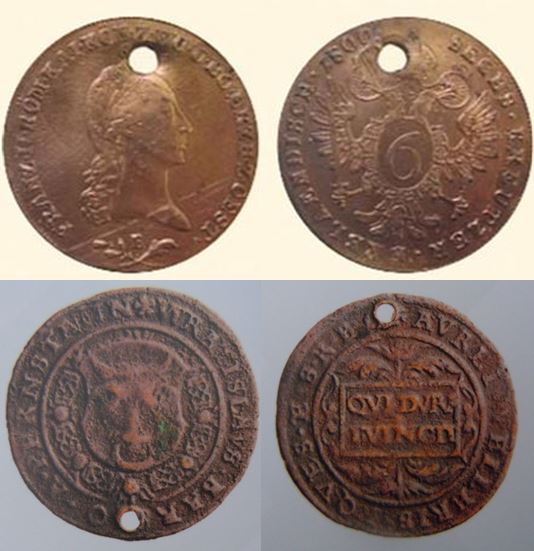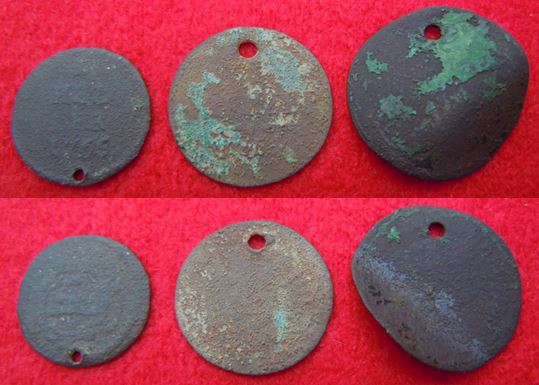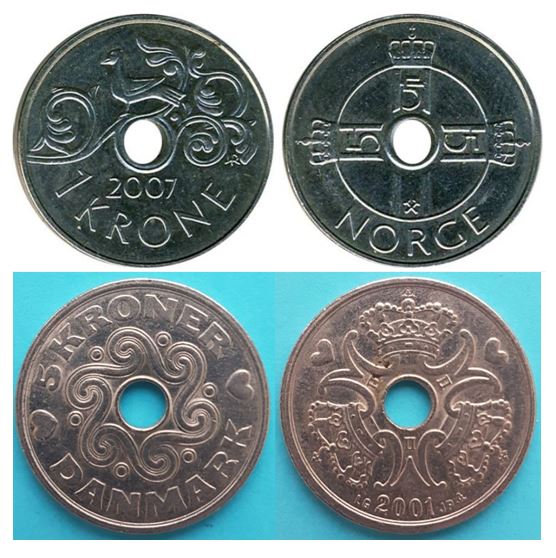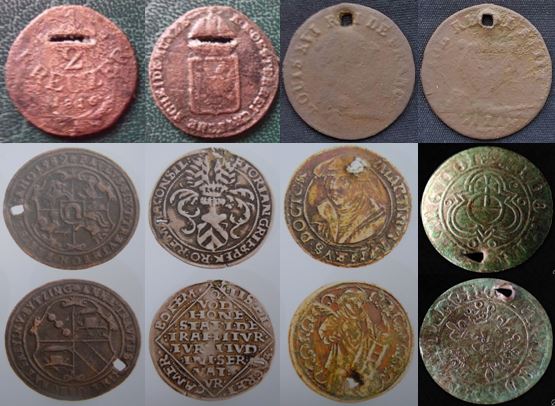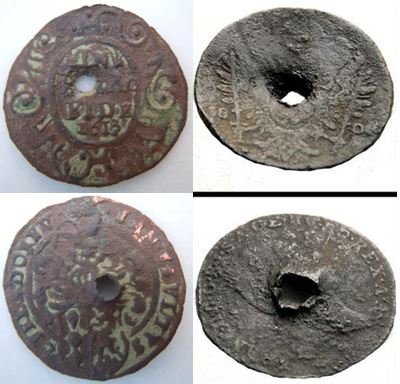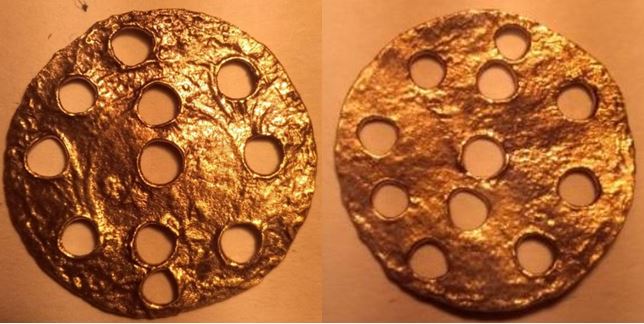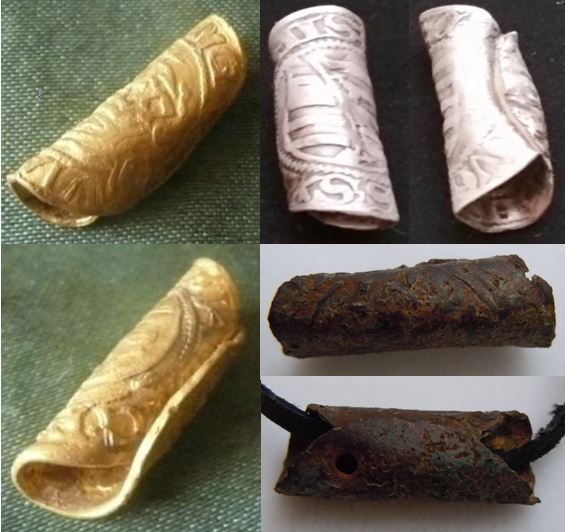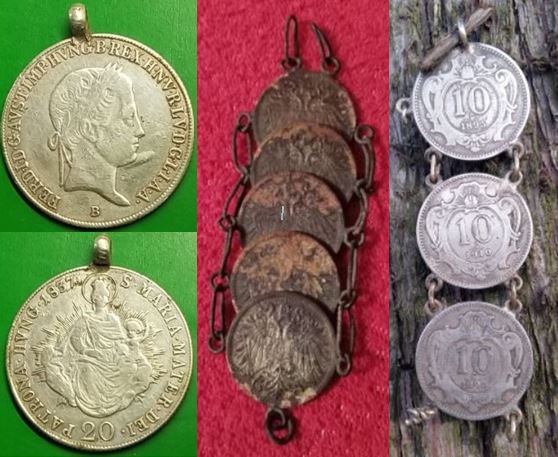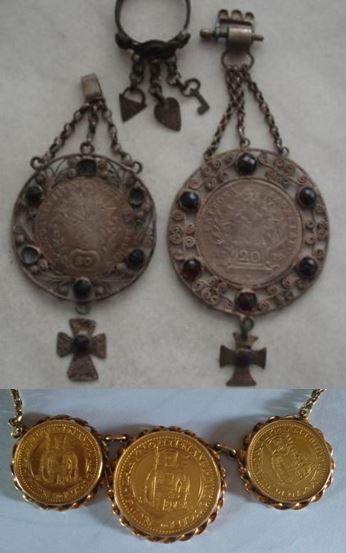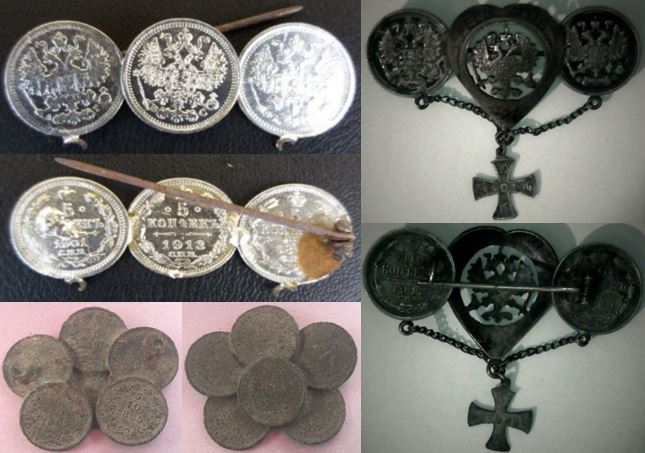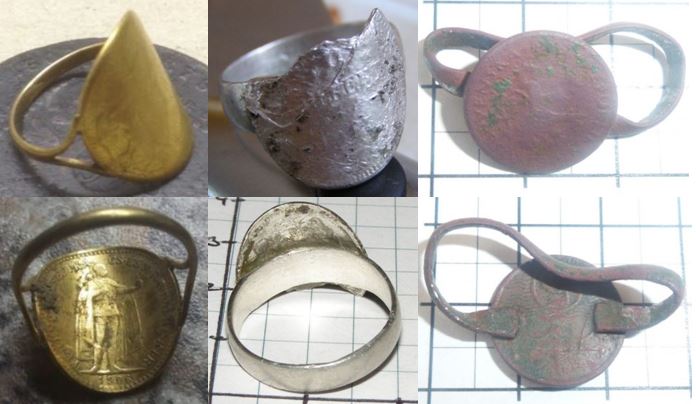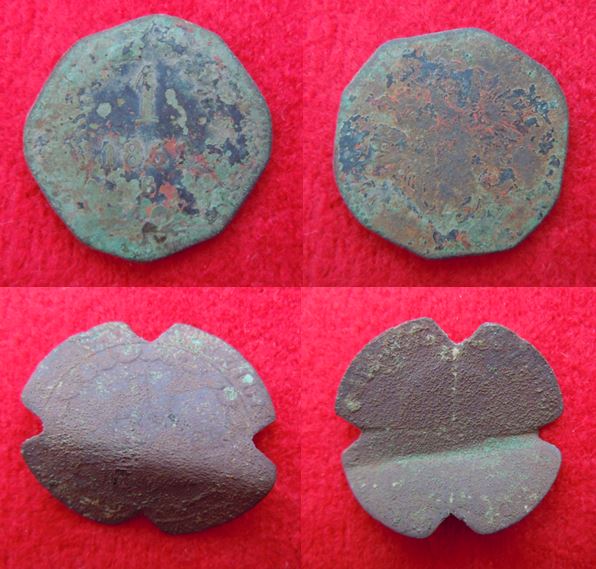Ahoj perfektně napsané. Četl jsem jedním dechem 1s*
Holes in coins and their other modifications
Categories: Minting - Numismatics , Finds and rescue research in the Czech Republic
Earlier this year, I managed to find a copper coin rolled into a roll. But its primary treatment was perforation. This secondary treatment alone leads one to wonder why the coin was rolled if it already had a hole? Did the strip of leather tear so often that the owner decided to roll it up and thread a much thicker string through it? In the course of searching for information as to why coins were altered into rolls, not just copper, but also precious metal, I decided to try to piece together a few lines offor what reason and for what purpose the coins were not only rolled, but especially perforated, and also to summarize their other modifications, such as coin clipping. In doing so, I make no distinction as to whether the coin is a monetary system coin, a numerical coin, or a commemorative coin. In the pictorial appendix most of the photographs of your finds published on the LP website are used, from the followingwebsites, professional publications, from my personal finds and one photo is from my friend's great-grandfather's inheritance. As for sources of information on certain points, unless directed to a link, this is merely my personal opinion, which you may or may not agree with. While I won't participate in any discussion, I will certainly follow it closely. I will be glad and thank you in advance for any links to sources of information on this topic, but especially on the roll-editing of coins.
'' Holes in coins ''
- A hole in the edge of a coin most often used to hang the coin as an ornament or amulet 1. Its location is arbitrary anywhere around the circumference, or planned in a place above the head or below the portrait of the ruler or other depiction (Madonna, coat of arms) because of the view of this image. If the wearer wanted to see the image directly by simply tilting his head, he made a hole at the sixth hour in the view of the coin as on the face of a clock. Passers-by observing the decoration, however, saw the image upside down.
- Another use of the coin, which has one or two holes around its circumference, was to sew them onto clothing as ornaments. Coins of lower denominations such as grešle or pennies were used for this purpose. Punched coins, or rather imitations of them, were sewn individually or as sets on chains on the costumes of dancers as glittering ornaments in the Middle East. Their jingle enhanced the effect of the dance. (Popularly, the small coin was called a trinket from the Latin quintus = five; later, associated with the sewing of these coins onto clothing, the trinket took on the meaning of a worthless ornament 1)
- A hole made by a nail after nailing it to a pillory. This informed the invalidity of the coin in question. This is directly documented from the reign of George of Poděbrady. These were Austrian worthless pfennigs called shinderlinks, which contained only 0.01g of silver from their weight of 0.38g 1. The information given in this way, for example by nailing coins on trees in villages, doors and doors of inns, taverns, pubs, pubs, pubs, beer halls, breweries or taverns was probably not done for coins with a higher content of precious metal. This would certainly have led to people stripping them and melting them down into silver bullion.
- If there was any doubt about the authenticity of the coins, the person in question could have punched a random coin to find out what material the core was made of.
- Two opposite holes around the edge at either the third and ninth or the twelfth and sixth hours. Double threading of the string ensured that when pulled tightly to the neck it would not turn and still expose the selected side of the coin, or was used to join it into a simple chain.
- Coins with a regular hole in the middle of a square or circular diameter were produced in the Far East (China, Japan). They were strung on strings and counted on 'strings'. In Europe, there are also such coins originating in the Scandinavian countries 1.
- The discovery of a coin that has two holes in its centre gives us the possibility to believe that the coin served as a button.
- The piercing in the middle of the coin can also be explained by the fact that it was used as a backing. This is proved by the Prague discovery of a numeral coin directly on Stud 2. It is safe to say that no one would probably use a coin made of precious metal for this purpose.
- The three or four holes around the circumference of the coins were used to join them and make a bracelet.
- The multiple piercings of the coin lead to one question. Why and for what purpose was the coin pierced in multiple places?
Many objects can be used to make a hole, and we see many different shapes of holes. A drill, nail, awl or other sharp-edged object with a circular diameter can be used to make the most common round hole. Square and rectangular shapes can be made with a nail or staple with this shank shape. A triangular shape suggests a hole made by the tip of the knife. Some of the holes are left without further modification, while others are modified by splitting the edge or filing off the resulting burr.
'' Other coin modifications ''
- Rolling the coin into a roll. Now and then a gold, silver, or even copper coin is found modified in this way, but only as a solitary find. It is often suggested in discussions that this was done with gold coins to protect them from robbery, when the coils were strung on a string or a strip of leather and tied around the waist or above the knee so that they would not be seen. In the event of a robbery, the person would not lose them, but would just hand over the purse with the silver coins. In this case, I'm still looking for a verified source for this description. I am aware of concealing coins by tucking them into a double-walled belt, but I have found nothing about coin scrolls. So far, all the researchers I've contacted and worked with have come up with this explanation of the reason for rolling the coins and no clear answer as to why it was done was given, I was only referred to the so-called "Taufgeschenk". I am not even aware of any depot containing a coin so altered. I have been told of one denarius rolled up in a roll from the 11th century, otherwise most coins so altered are said to date from the 16th to 17th centuries. This corresponds for the most part with the findings published on the LP website (Sigismund of Luxembourg (1387-1437)_ducat, Vladislav II. Jagiellonian (1471-1516)_ducat, 2x Archduke Charles II (1564-1590)_ducat, United Provinces of the Netherlands (1581-1795)_ducat 1649, 2x Ernst, Wilhelm III. der Tapfere and Albrecht III. der Mutige (1465-1482) - Spitzgroschen_Ag, Rudolf II. Habsburg (1572-1611)_Ag, Sigismund III. Vasa(1587-1632) - 3 Grosze_Ag, Ernst August I.(1662-1698) - 4 Mariengroschen_Ag, Hans Krauwinckel II.(1586-1635)_number coins + two unspecified specimens (Nuremberg?)) There are two finds in the museum records. One specimen from Prague and the other from Rakovník, both from Nuremberg numerical coins. My find is also, so far only tentatively identified, as a roll from a Nuremberg coin of Nuremberg provenance from the first half of the 16th century. This makes me wonder if it was an ornament in the form of a so-called ''capsule coin''. Numbers were minted in Nuremberg already during the 15th century. So let's give it some time to develop a custom. Later, by studying ethnography in the German lands, we learn about the custom of having a capsule coin, in the form of a number coin, which was supposed to attract more money to the owner. Perhaps the owner rolled it into a roll and wore it as an amulet around his neck, because he had neither a purse nor a purse at the time. Another might have thought that if he made the capsule penny out of a gold coin, it would enhance its power and it would attract equals and the gold coins would just flock. For specimens from 15. In the case of examples from the 15th century and earlier, the coiling could only be done for the sake of ornamentation or the absence of a purse.Another conjecture to explain the separate discovery of a gold or silver coil. What about such a ''Taufgeschenk'' gift from a godfather or godmother given at baptism. Just a simple gift of gold for the cradle? But when they roll it up, thread a thick strip of leather through it, immediately there is a golden ornament with a memory of the godfather with a relatively strong attachment against breakage and subsequent loss. And if the godmother is not wealthy, the gift can also be made of a silver coin. In such an ornament is hidden both the memory mentioned and a certain amount of money, because to straighten a ducat is not beyond human strength. Perhaps the owner of the coin wanted to make only a gold ornament by rolling it up. He didn't want to drill or punch through it, knowing he could pay with it at any time. In the case of a perforated coin, he might risk reducing its value by the missing precious metal content of the hole. It would be easier to roll it up without gross mechanical damage.
- One or more multiple edge chops on ancient coins were used to determine the authenticity of the coin material 4.
- In Bohemia, we have evidence of the edge of a denarius coin being cut to check the material of the 1, or it could have been used to break the coin so that it could be paid twice 3.
- By attaching a loop or loops to the edge of the coin for hanging it as a neck ornament, but also as part of an earring, or linking them together to make a bracelet.
- By attaching the eyelet to the centre of the coin to make a button.
- Making a plain or decorated hoop around a coin with an eyelet in which the coin is inserted or the hoop is soldered to the coin. There may be several eyelets and by linking them together the main part of the necklace is formed.
- Gluing the coin to the decorative backing with collar and eyelet.
- Fusing several coins together by overlapping parts of the faces and attaching a needle to form a clasp.
- Making a ring from a coin.
- Cutting and filing a pattern in a coin.
- Alterations made with the intention of changing the shape of a circular coin by grinding, filing and other means for purposes unknown to us.
Yours sincerely Martin Král.
1. Hole on the obverse side of the coin at 12 and 6 o'clock
2. Cetky penny 1765 1-4KR 1851 1-2KR 1812
3. Two opposite holes
4. Top and middle China 12th and 17th century, Japan 20th century.JPG
5. Norway 1 kroner, Denmark 5 kroner
6. Other hole shapes
7. Coins with holes ala button
8. Coins ala washer
9. Three, four holes
10. One hole is not enough
11. Gold, silver and copper coil
12. Chopped and clipped coin
13. Eyelet or eyelets
14. Coin with a loop in the middle like a button
15. Hoop with eyelet and glued to a pad with an eyelet
16. Decorated bezel and coin in bezel joined with eyelets to form a necklace
17. Clasped coins in the form of a clasp
18. Coin rings
19. Carved coin motifs
20. Coin designs to ponder
Literature and other resources including image attachments:
1 Illustrated Encyclopedia of Czech, Moravian and Silesian Numismatics_Zdeněk Petráň
2 Information from the museum
3 https://docplayer.cz/14653727-Cesti-vedci-maji-unikatni-objev-minci-z-11-st.html
4 Fundamentals of monetary development_Jiří Sejbal
Government and private numerical coins (14-17.century)_Kamil Smíšek
https://www.lovecpokladu.cz
https://www.numisbids.com
https://karvinsky.denik.cz
https://enigmaplus.cz
https://www.numismaticodigital.com/
http://sbiramemince.cz
https://www.penize.cz
https://pixabay.com
https://smenarna-praha-1.cz
The article is included in categories:
- Archive of articles > Minting - Numismatics
- Archive of articles > Archaeology > Finds and rescue research in the Czech Republic
Post
Super 
Sice pro mě asi nic nového ale článek je pěkně napsaný a určitě si ho rád přečte každý  Děkuji že si si s tím dal tu práci.Už mám tak nějak od všeho něco jen ta zlatá rulička se mi zatím vyhýbá
Děkuji že si si s tím dal tu práci.Už mám tak nějak od všeho něco jen ta zlatá rulička se mi zatím vyhýbá 
Tak tohle je pecka příspěvek a to nejsem mincičkář.
Díky za fakt dobře napsaný článek, dalo to určitě dost práce, pár mincí s dírkou jsem taky už kopl, krásný je ten zlatý prsten z mince, aspon' se mám pořád na co těšit. At' se daří. 

krásně se to čte i prohlíží 



Pěkně napsanej článek, díky 
Krásná práce! Díky! 
Cemente něco podobného mě hned napadlo taky.Pokud tedy myslíš ten Krejcárek vypilovanej křížem.Prostě mi přišlo že tam bylo něco omotané nebo že to byl třeba konec nějakěho např.provázkového talismanu kdy např.poslední článek byla ta mince s provázkem křížem 
Hezký,zajímavý a poučný článek-dávám palec 
Díky za perfektní čtení jen se zeptám dá se do téhle kategorie dát i mince kterou udělali jako klíček k hodinkám? 

vojtas83 určitě taky  je to výrobek z mince ale jde o úhel pohledu.Mince/klíček.
je to výrobek z mince ale jde o úhel pohledu.Mince/klíček.
Pěkný článek, dobře se to četlo.. Mám několik mincí s dírkou i očkem, rulička se mi zatím vyhýbá.
Důvod stáčení do ruličky je jasný...ještě neměli papírové bankovky a něčím se šňupat muselo... 
Dobře zpracované téma.
Konečně zase jednou článek, který stojí za přečtení a do kterého autor vložil nejen svůj pohled na věc ale hlavně vlastní úsilí. Nemám rád ty zkopírované články, kterých je zde poslední dobou jako hub po dešti. Pecka kolego, kvituji s povděkem.
Děkuji za článek, parádně napsaný.
Paráda  mooc velká ...děkujeme
mooc velká ...děkujeme
Pekne zpracovano. Videl jsem z 3 krejcaru 1800 vyrobene radlo na testo 
otravnykomar-děkuji za poznatek  takže lidová tvořivost nezná mezí.Je možná jen otázkou času než se najde další využití mince.
takže lidová tvořivost nezná mezí.Je možná jen otázkou času než se najde další využití mince.
SUPER článek a předpokládám že i mravenčí práce v rešerši podkladů na dané téma.
Mylím že odedneška budeme (alespoň já určitě) pohlížet na svoje mincičky s dírkou a nebo srolované, pohlížet trochu z jiného úhlu. Třeba jen - komu dělaly radost a kdo je mohl nosit jako železnou zásobu, nebo jen pro štěstí.
Svědčí to o tom jaký měli naši předci vztah k platidlům a jak si vážili každé "zlatky".
Asi jim nikdo nevyčítal znehodnocení mněny a možná neměli tolik šmuků k ozdobě oděvu či těla.
Díky za takovéto články které posouvají pohled na "vymrcasené nálezy" do světla většího porozumění naší minulosti.
P.S. - Je to mnohlem lepší počtení než některé "moudré"poznámky u nálezů.

Krásý článek.Jen přidám můj názor.Hodně takových mincí se používalo na postroje zvířat jako ozdoby a to na chomouty a řemení a nejen końských,ale i ostatních tažných zvířat.Lidé tím nahrazovali drahé faléry.( proto i ty zvláštní tvary )
Děkuji za zajímavé počtení, klobouk dolů, krásná práce.
Super článek díky 

Parádní článek, moc pěkně zpracované.
Moc pěkný článek  Vidím zde i svou Korunu 1915 v obroučce
Vidím zde i svou Korunu 1915 v obroučce 


Výborně zpracované, četlo se to jedna radost, i s nadějí že se dozvím, proč mince roztloukali na užší plíšek, kde skoro není poznat nominál. Našel jsem Ag 1 korunu, a nikdo mi to nevysvětlil. Škoda, ani tentokrát to nevyšlo,  )), ale nešel jsem v článku dost odpovědí na jiné otázky. Díky za článek.
)), ale nešel jsem v článku dost odpovědí na jiné otázky. Díky za článek.
www.lovecpokladu.cz/artefakty/nalez/1-korona-178951/
Úžasně sepsano, děkuji!
Opravdu zajímavý a dobře zpracovaný článek.
Mám dvě mince se zářezem, které jsem tady nikdy nezveřejnil, protože jejich stav je špatný. Vždycky mi ale vrtalo hlavou, proč mají dvě různé mince nalezené cca 50km od sebe, podobný zářez. Nemyslím si že, by to bylo z důvodu ověření materiálu. Spadají tedy do poslední skupiny popsaných mincí - k zamyšlení.
Odkaz na moje fotky mincí se zářezem : https://ranec-diver.rajce.idnes.cz/Mince_se_zarezem/
Parádní příspěvek,jen tak dál 

Moc pěkný ! 
Děkuji za rozšíření obzorů. Moc hezky je to napsané a dalo to práci a stálo určitě hodně času. Já našel zatím jen provrtaný desetník, asi na podložku.
To kostinF5 - a v místě nálezu nevede poblíž náhodou železniční trať? Jestli ano, tak si někdo mohl zaexperimentovat. A vlaky už tady jezdí taky docela dlouho.
To Mildes ...vlak ani nic podobného. Bylo to u Veseckýho rybníka (Tajch). Jen jsem se pak dozvěděl, že v lese byla za RU, střelnice. Ale jestli tam vedla nějaká železnice, to nevím. 
Až dnes jsem na články zavítal . Moc hezky a poutavě napsané a zpracované. Také jsem nalezl několik mincí s dírkou jak Ag tak mince Cu některý otvor byl po vyražení ještě ostrý většina ale asi od nošení vyhlazena. trochu doplním mince Čínské se od prvopočátku odlévaly z bronzu do pískových forem kdy bylo vytlačeno několik desítek mincí do tak zvaného mincovního stromu .Po odlití se mince odlamovaly uprostřed byl onen čtyřhraný otvor , mince se navlékly na trn a povrch mince se ohladil od toho zbytku po odlití , a to již několik století před našim letopočtem . Poté se vázaly jak zde psal již pan Král . Před nějakou dobou se mi podařilo koupit větší množství mincí Ag Ruských carů jsou to ty mal nepravidelné říkalo se jim drátovky a mezi nimi i pět mincí stočených do ruličky dost jich bylo pokryto oxydací i když prodávající je čistil byla ještě dost patrná na několika mincích z čehož jsem usoudil že se jednalo a nalezený depot.Těch mincí bylo na prodej více ale mě se zadařil první nákup ,o dalších jsem již neuvažoval prodejní cena rapidně vzrostla poptávkou .Mince které jsou stočené pocházejí z ražby před Petrem I jelikož on dost snížil váhu mincí .Těch pět roliček váží 1,4 gr a převážil jsem mince Petra I čtyři mincičky jen 0,6 gr Prodávajíci byl podle jména Ruské nebo Ukrajinské národnosti . Jestli by pan Král měl zájem mohu zaslat foto těch ruliček ještě je trochu znát ražba .
Moc pěkný článek.Díky 
Super napsane a hodne zajimave dekuji 👍
Velice zajimavy a poucny clanek super !!
Moc pěkně zpracováno  dobré počtení
dobré počtení

Super článek, ale ja mam minci jejiz proděravění jsem zde nenašel. A sice dvě malé dirky vedle sebe v horni casti mince. Kdyby byla jedna, je to dirka pro očko na pověšení na krk, ale k cemu ta druha hned vedle?
Možná použita jako knoflík Makoves?
Martinkale diky za tip, ale to jsem vylocil. Ty dirky jsou moc vysoko.
Ok, tak už mě napadá jen ozdoba, nějaká lidová tvořivost
Na dva krky 

Dvě stejné lehce oválné dírky (na výšku) na dvanácté hodině ((přesněji 11:55 a 12:05 (hlava panovníka vzhůru)) . Okraje začištěny. Podle mě se jedná o připravovaný přívěšek. Dvě dírky pro lepší nošení. Při jedné se mince stáčí na jednu stranu. Slabý řetízek či kožená šňůrka na provlečení přes dvě dírky zajistí jeho rovné zavěšení. Samozřejmě do těch dírek můžou přijít i kroužky a řetízek/šňůrku jimi protáhnout. Ale mohlo by se to i natrvalo někam přišít, třeba jako medaile, ale ta pravděpodobnost na takovéto použití je dle mě malá.
Pěkný a nový exemplář pro případné pokračování.
Majiteli děkuji za zaslaná fota.
Ad "mince k zamyšlení" - ta ve tvaru čtyřlístku podle mě mohla být našitá třeba na kabát - okolo panovníka by pak byl čtverec postavená na špičku.
